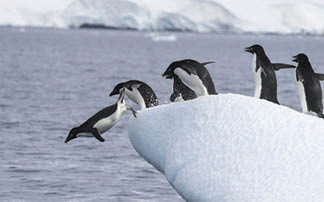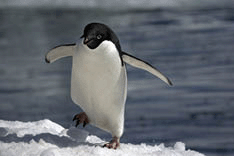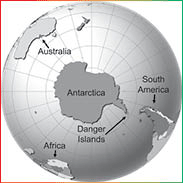Return to 3rd Quarter 2021 articles.



Scientists were concerned that the population of this penguin species was declining until a recent discovery on the Danger Islands.
Adélie penguins (Pygoscelis adeliae) live on the perimeter of Antarctica. They have a “follow the Sun” migration. During summer in the Southern Hemisphere, they remain on the edge of the land. As winter comes on and the Sun moves northward, the ice fastened to the Antarctic continent extends farther north. Adélie penguins migrate northward at that time, following the growing ice so they can stay in the sunshine. In the spring, as the ice recedes, the Adélie remain on the edge of the ice as they migrate southward to their breeding grounds on land. For many of the Adélie penguins, their annual migration can be 8,100 miles (13,000 km).
The penguins were fearless because Adélie penguins had no experience with humans or other animals when the early Antarctic explorers were crossing the ice with their dogsleds. As the dogs barked at the Adélie, the penguins seemed to think that it was some kind of greeting. They would run toward the dogs. The louder the dogs barked, the more excited the penguins became to greet them. When the penguins got close enough that the harnessed dogs could reach them, the dogs killed them. If the dogsled driver tried to catch the penguins to move them away, the penguins would fight to get back to the dogs. It was a frustrating experience for the explorers.

Adélie penguins may not know to stay away from dogs, but they are well adapted to their environment. Because they are exposed to very salty water in the desert of Antarctica, they have unique adaptations. They eat krill, which has lower salt concentrations, and their stomachs alter the ion concentrations to reduce sodium and potassium ions. They feed their chicks with regurgitated krill that they have partially digested and desalinated. The adults concentrate the salts in their waste, and they have nasal glands that remove excess salt, which the penguins eject from their nostrils.

But what about the discovery on the Danger Islands? The Danger Islands of Antarctica should not be confused with Danger Island in the Indian Ocean. These islands are located at the tip of the Antarctic Peninsula. Explorers in 1842 gave them the name Danger Islands because they are “guarded” by icebergs which are dangerous to ships. Scientists were concerned about declining numbers of Adélie penguins until they discovered 1.5 million of them nesting on the Danger Islands in 2018. That almost doubled the known population.
Scientists studied the Danger Islands population by using drones, which are not endangered by the icebergs. Human creativity, ingenuity, and curiosity have provided a way for us to study and care for these penguins that God has given the ability to survive in a hostile environment.
Picture credits:
© vladsilver. Image from BigStockPhoto.com.
© Moritz Buchty. Image from BigStockPhoto.com.
© BFordyce. Image from BigStockPhoto.com.
